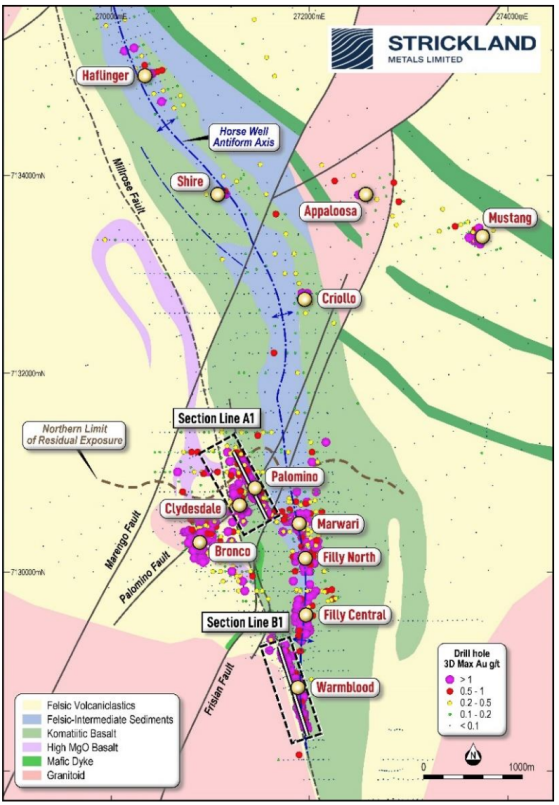The latest drilling results from exploration drilling by Strickland Metals Ltd (ASX:STK) at its 100%-owned Horse Well Gold Camp in Western Australia further support the presence of a large-scale gold system.
Recent drilling at the Warmblood and Palomino deposits delivered high-grade results that include 7.9 metres grading 9.7 g/t gold at Warmblood and 10 metres at 6.9 g/t gold at Palomino — and importantly, point to a large-scale gold system consisting of a network of interconnected mineralised structures.
Strickland has already defined the gold mineralised system over a strike length of four kilometres but it is now clear that the system has strong potential to extend for at least the same distance under transported cover to the north where previous shallow drilling is deemed to be largely ineffective.
“Very significant” results
Strickland managing director Paul L’Herpiniere said: “These results are very significant, not simply because they are strong intersections in their own right but also because of what they are telling us about the Horse Well camp as a whole.
“The company has recently made significant progress in understanding the geology of this well-mineralised area and, most importantly, now has a clear understanding of the major camp-scale controls on gold mineralisation.
“It is exciting to see the interconnected nature of these ore-controlling structures, which is giving us confidence that potentially a very large gold deposit may be emerging at Horse Well.
“The combined effects of very deep weathering and historically shallow drilling have concealed the magnitude of this opportunity until now. However, the company’s current program of deeper drilling is now confirming multiple high-grade mineralised shoots open at depth.
"One geological pattern that is well known with Orogenic gold deposits such as this one is that we always see multiple stacked ore shoots as we drill deeper.”
Revised geological interpretation highlights the emerging Horse Well Gold Camp. Note continuity of ore-controlling structures and that most known mineralisation is restricted to the area of residual exposure.
Warmblood deposit
Ongoing extensional diamond drilling at the project’s Warmblood deposit has continued to intersect high-grade gold mineralisation immediately below the existing shallow resource.
Results include:
- 7.9 metres at 9. 7g/t gold from 138.5 metres, including 3.2 metres at 22.0 g/t (HWDD042);
- 5.2 metres at 3.1 g/t from 171.1 metres, including 2.2 metres at 7.0 g/t (HWDD043); and
- 14.4 metres at 6.0 g/t from 114 metres, including 7 metres at 10.6 g/t (HWDD017).
Strickland notes that the results extend the high-grade mineralisation a further 170 metres down plunge and the mineralisation remains totally open at depth and along strike.
Of significance for the resource potential of the deposit, the deepest intersection is only ~140 metres below surface.
The company also reports the following significant results from additional infill RC and diamond holes:
- 7.4 metres at 4.9 g/t gold from 49.6 metres, including 3 metres at 10.6 g/t (HWDD029);
- 14.6 metres at 1.5 g/t from 102.5 metres, including 3.3 metres at 4.2 g/t (HWDD039); and
- 6 metres at 2.5 g/t from 102 metres (HWRC329).
RC drilling continues to test the northern extents of this 1.4-kilometre mineralised trend at Warmblood. Deeper diamond drilling is also planned to follow up these results and further define this high-grade primary mineralisation.
Palomino deposit
Assay results from the Palomino deposit have extended the high-grade mineralisation a further 150 metres along strike from the existing resource. These include 10 metres at 6.9 g/t gold from 170 metres, including 2.1 metres at 15.1 g/t (HWDD034).
Additional RC results have demonstrated that the upper portion of this high grade (+30 gram x metre) primary mineralised domain is more than 300 metres in strike length, while the oxide footprint is at least 700 metres in strike length.
The deeper portions of the high-grade primary mineralisation remain open at depth, both down plunge and along strike.
Read more on Proactive Investors AU
